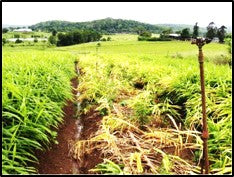Combating major diseases and insects of Ginger

Ginger,Zingiber officinale is an herbaceous perennial, the rhizomes of which are used as a spice. India is a leading producer of ginger in the world and country produced more than 11 lakh tonnes of the spice from an area of 1. 65 hectares.

Ginger is cultivated in most of the states in India. However, states namely Karnataka, Orissa, Assam, Meghalaya, Arunachal Pradesh and Gujarat together contribute 65 per cent to the country’s total production.It is used as a spice on a large scale and in the preparation of pickles, beverages, medicines and in some parts taken for fresh consumption.
Ginger can be grown both under rain fed and irrigated conditions.Ginger thrives best in well drained soils like sandy loam, clay loam, red loam or lateritic loam soils. While cultivation of ginger, farmers face so many problems including pests and diseases.
Major diseases and pests of Ginger are:
1.Soft Rot or Rhizome rot disease is the most destructive disease which can reduce the production by 50 to 90%.It is caused by the fungi such as Pythium aphanidermatum. Pythium vexans and Pythium myriotylum.

2.Bacterial Wilt most serious rhizome-borne disease caused by bacteria Ralstonia solanacearum. It is a soil and seed-borne disease. Bacterium causes rapid wilt in ginger within 5–10 days of the infection.

3 . Leaf spot diseases are caused by Phyllosticta zingiberi, Helminthosporium, Colletotrichum, Pyricularia can be seen on the leaves from July to October. The disease initiates as a water soaked spot and later turns as a white spot surrounded by dark brown margins and yellow halo.

4. Root knot Nematodes (Meloidogyne spp., Radopholus smilis, Pratylenchus spp.) also infests ginger crop in some areas and some seasons.Infested plants show stunting and chlorosis and marginal necrosis of leaves

5. Shoot borers (Conogethis punctiferalis) cause holes in the pseudostem by feed on internal tissues resulting in yellowing and drying of leaves of infested pseudostems.

6.White grubs (Holotrichia spp.) are also major pests of ginger crop.The grubs make large holes in rhizomes which leads to reduce market value of produce.

7.Rhizome Scale (Aspidiella hartii) the white coloured scales are seen scattered on rhizomes and later they gather near the growing buds. When the infestation is severe the buds and rhizomes will shrivel and ultimately the entire rhizome dries.

8.Bacterial Soft Rot caused by Erwinia chrysanthemi. This pathogen is a part of disease complex.

Among them soft rot disease is more severe in high moist areas with little lower temperatures
Soft Rot disease is caused fungi Pythium aphanidermatum, Pythium vexans and Pythium myriotylum.

Symptoms of soft rot caused by Pythium spp.
Nature of Damage:
- The fungi builds up along with the soil moisture especially during the monsoons.
- Young sprouts are the more susceptible ones.
- The collar region of the pseudostem affected by soft rot becomes water-soaked.
- The rotting spreads reaching the rhizome.
- The rhizomes grow soft and begin rotting and hence the name ‘soft rot’


Leaf symptoms of soft rot caused by Pythium spp.
Symptoms of the disease
- Affected region becomes water soaked
- Middle portion of leaves are green while margins turn yellow.
- Yellowing spreads upward as well as downward to other regions.
- Pseudostems dry and wither
- The infected shoots are very easy to pull out from the soil.

 Rhizome rot caused by Pythium spp. Spreading of Disease
Rhizome rot caused by Pythium spp. Spreading of Disease
- Spreads through rhizomes
- Affected spores pre sent in soil
Management of Disease
- The most important step here is to select soil that does not hold water soil must drain off water quickly.
- Seed rhizomes must be chosen from disease-free gardens.
- Drench with Ridomet75 gm per litre and drench in dry conditions and 2-3 gm per litre in wet or rainy conditions.

- After 6 days Neel Cu [Copper EDTA]5 gm per litre and drench in dry conditions and 1.5 - 2 gm per litre in wet or rainy conditions.

- Seed treatment with Ridomet 1 gm/L of water or spray on the seed rhizomes stored in dry conditions. Spray should done uniformly on the cut seed rhizomes and this seed treatment help to prevent the disease at later stages.

- As we can't do drenching for all plants we can try an alternate method by mixing 1Kg Neel Cu [Copper EDTA] + 10Kg 20mm Sand throughly and broadcast it to field when the moisture level is optimum or can apply after irrigation.
********
Revised by
Navyashree M S
Junior Agronomist,
BigHaat
For more information kindly call on 8050797979 or give missed call on 180030002434 during office hours 10 AM to 5 PM
_______________________________________________
Disclaimer: The performance of the product (s) is subject to usage as per manufacturer guidelines. Read enclosed leaflet of the product(s) carefully before use. The use of this product(s)/ information is at the discretion of user.












What is the immediate treatments for soft rot disease of Ginger?
ಶುಂಠಿ ಬೆಳೆಗೆ ರೋಗ
Hello sir, Namaste, thanks for your contact, neel boom is a fungal disease for ginger which reduces the 50 – 90% crop production
Hello sir, thanks for your contact, https://www.bighaat.com/blogs/kb/combating-major-diseases-and-pests-of-ginger, check this link you will get all information of ginger crop diseases
What the neel boom do and for what
Leave a comment